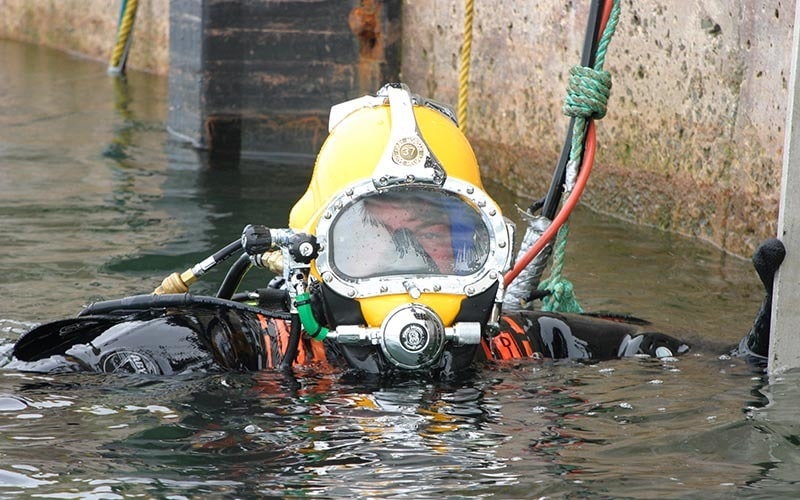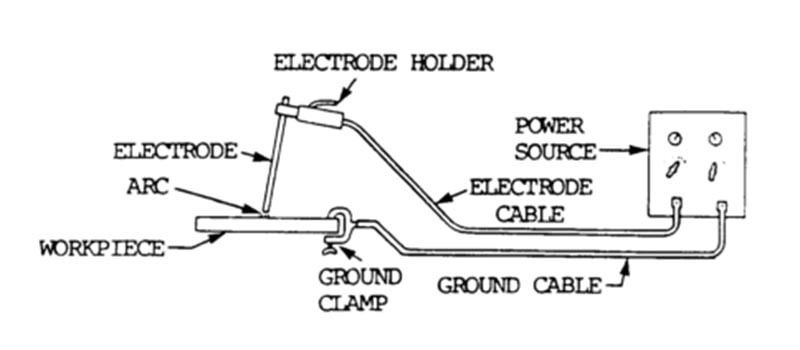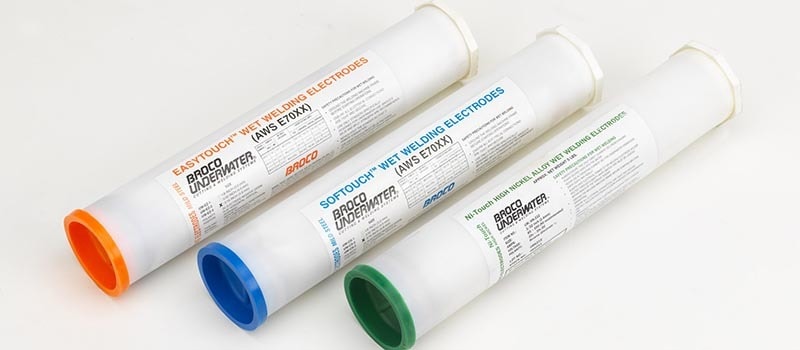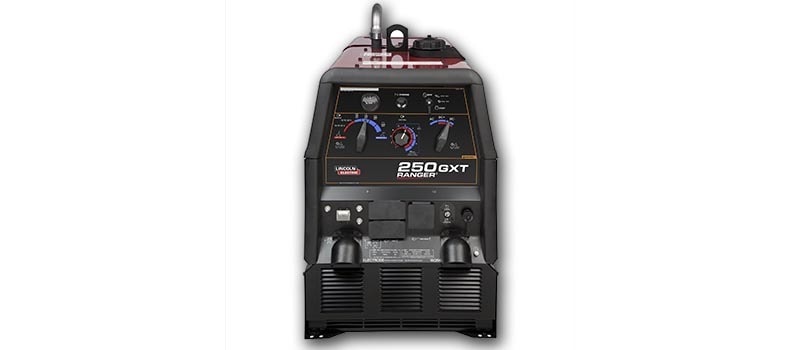Underwater Welding Equipment: Stinger, Electrode & Machine
Last Updated on

Indiana Jones keeps his whip handy, and Thor always packs his hammer to vanquish his foes. So it is with underwater welders. Each chooses preferred brands of their equipment, but all must use three essential items to complete their assigned welding projects: A welding machine, stinger and electrodes.
This equipment can vary in range of price, quality and effectiveness. And just as in surface stick-welding, underwater welders must choose the correct stinger angle and electrode diameter to fuse the seam. Splatter is splatter – it doesn’t matter if the excess is of “higher quality” or not. You can think of this as a buyer’s guide to wet welding or a buyer’s guide to Underwater Welding Equipment, not dry/hyperbaric welding. Dry underwater welders conduct their projects in a dry environment similar to surface welds, so there’s no need for specialization with these three equipment types.
Unlike more standard diving equipment like a helmet, suit and other accessories, maritime companies will foot the bill more often than not for product purchases. Still, it’s important to know the product specifications involved. You may take part in the decision-making process of which underwater welding equipment to buy.
Stinger

Stingers, also called electrode holders, serve the same purpose on surface level or below water: they provide an outlet for the power and give the welder control over their arc.
The BR-21 is a great example of a versatile stinger with the right blend of ergonomics and high end material.
Topside stingers often come in different shapes and sizes depending on the machine source amperage and “grip” preference of the welder. Underwater welders have some flexibility with stinger options, but most come with these two characteristics:
- Thick insulation (due to the highly conductive atmosphere)
- Twist style (as opposed to alligator style with clamps)
Price
$150 – $250
High quality stingers used for surface-only run around $70 – $150. Underwater welding stingers are backed with countless hours of testing and research, especially for safety reasons. And few companies manufacture them.
Another reason for their high value? Most underwater welding electrode holders can do double duty on land or in water.
Assembly & Mechanics: Examining Electricity-Powered Guns

- Next to quality, simplicity is crucial for the maintenance and repair of underwater welding stingers. Look for stingers that have removable parts and can be easily taken apart and put back together again. On the job, you won’t have time to have another stinger shipped to you, or spend all day working on the one you have.
Stinger Head
Take a look at the stinger head. Is it made of a sturdy material – both on the outside and inside where the electrodes are placed? This is where the Broco BR-20 stinger shines, with a stinger head that’s been tested in the deepest of waters.
This is the portion that will receive the most wear, so it needs to last. Some stinger heads extend out like a garden hose, and others just come straight up with a hole for the rod. Either works well.
As a bonus, check the inside for a notch; an indentation that will guide your electrodes into place before using them. This is especially helpful in low to zero visibility. The head should also allow for multiple sizes of electrodes for different weld jobs.
Check the angle of the head to make sure it’s comfortable for your work. This often depends on the length of your arms and torso. Luckily it’s not as much of an issue as topside welding, since your underwater buoyancy will allow you to work higher or lower on your weld.
The Handle Grip
Adjustment capability helps provide a more custom fit for the grip section of your stinger. Making an adjustment should be as simple as rotating your hand to raise or lower the head section. The best grips have at least some indentations to press your fingers into like a joystick on a game console. Also, look for optimum grip thickness: Test the grip with gloves on, since you’ll be wearing gloves on the job.
When welders experience arm fatigue, they can put the blame on one of the two things: thee stinger or their technique. Usually, it’s a combination of the two. An underwater welding electrode holder should be not only ergonomic but also lightweight. Explore your options and hold it above and under the water.
Wet Welding Electrodes

During the development process of wet welding, the electrodes proved the biggest challenge for inventors.
How do you electrify a rod and focus its energy on a weld in a watery environment? Even after they were able to produce results, they were less than satisfactory.
Underwater welding rods needed refining, and manufacturers have done just that.
Price
$100 – $350
Similar to topside electrodes, the pricing model is based off of electrode diameter and quality.
The Rod Test: What to Look For
Underwater electrodes don’t really have a specific “standard” to measure up to. Luckily, wet welding electrodes have ratings in several categories:
- Tensile strength (how well the electrodes hold up during the welding process)
- Yield strength (the large the yield strength, the more material the electrode produces per millimeter)
- Elongation (expressed by percentages, how far the electrode extends under stress)
- Amperage rating
Sometimes, welder-divers don’t buy wet welding electrodes.
They make them.
Old-fashioned divers produce wet welding electrodes with a special recipe: Coat regular, topside electrodes in waterproof gloss. This saves a lot on cost, but these coatings don’t last long – usually only for a few hours. And you run the risk of actually weakening the electrode’s yield strength by coating it with a foreign material.
Best to stick with electrodes specifically manufactured for wet welding. These include the SofTouch and Easy Touch line from Broco, coming in multiple sizes and materials.
These electrodes last longer under the hard-bearing ocean and lake water. Some are rated up to 24 hours, give or take. Shelf life is also important, so look for an electrode that has been carefully wrapped from head to tail in a sealing coating (some electrodes are covered with a waxy material to seal the deal).
Often, the higher the tensile strength, the better. Tensile strength is expressed in psi or ksi, and you can find it marked on electrode boxes through the first two numbers (60 = 60,000 psi). Yield strength gives you more bang for your buck: The higher the number (also psi or ksi), the more efficient your electrode will burn.
Elongation extends the electrode by a percentage of its length. I’ve read that a higher elongation is better, though I’m not sure of the science behind this.
Finally, amperage deals directly with the power of the welding machine you’re using, so there’s no better or worse rating. Just make sure it matches up or you’ll have a firecracker in your hands.
Underwater Welding Machine

What makes a welding machine (power supply) fit for underwater? Manufacturers don’t produce machines specifically made for underwater welding, so it’s kind of important for underwater welders to understand how their machine works before hooking up their whip and stinger.
But if you don’t know how to make the switch (topside to underwater), you can call a technician or the company supplier to help. Some welding machines require changing the output amperage or removing some of the innards (coils) to provide a proper setup for underwater use.
Price
$700 – $6,000
Welding power supplies are constantly adapted and developed. With new models coming out every year, the old models usually drop significantly in cost. Of course, design has a lot to do with it which I’ll cover in the next section.
Something Old, Something New: Which Welding Machine Type Works Best?
Companies and individuals have manufactured welding machines in many varieties, all of which have specific purposes for various welding types and power levels. SMAW (stick) welding has some of the most interesting and creative power supplies – car batteries, microwave ovens, you name it. Unlike some of the other varieties, it needs only one source: electricity. Here’s the most common designs for welding machines in general:
- Inverter – one of the most advanced designs allowing for more efficient electrical power conversion, overload protection and even automatic spot-welding.
- Transformer – cheapest and most common; gives welder control over output current and converts into low voltage, high current.
- Alternator/Generator – The simplest, most straightforward design with easy maintenance and transition of mechanical into electrical power often through a gas-power engine.
Homemade welding machines are fine to practice on topside; however, I don’t recommend using one for underwater wet welding, whether you’re practicing or on-the-job. These machines are usually constructed from used or “dead” appliances, like metal from your grandpa’s old refrigerator. Plus, you can’t properly test these parts like manufacturers can do in their high-tech labs.
Absolute Power: Look Within Your…Machine
As with topside machines, welder-divers need a welding power supply that will deliver a stable, uniform flow of electricity. The connecting power cables will extend longer – up to 30 – 40 feet under. Underwater welding jobs may require up to 400+ amps of power, so look for a machine with heavy output.
Alternating or Direct
The challenge of creating a more controllable current of electricity underwater made scientists and engineers turn to direct current (DC), as opposed to alternating current (AC). Underwater welders still use AC powered equipment such as a light or camera, but high amperage equipment must be operated through DC for safest results. If alternating current was to be unleashed in the surrounding water, it would rip through the diver like snot through a wet tissue.
Is AC more dangerous than DC? No, and it depends on how you’re using it.
Welding machines used for underwater wet welding application often make use of a step-down transformer to decrease voltage and increase current. And to convert the AC power over to DC, mechanical engineers install a rectifier inside the power supply. A rectifier comes in several forms, including diodes, valves and silicon. If you don’t have this on your welding machine, make sure you don’t need one for conversion to DC.
Polarity is also a factor in stick welding. To keep your electrode burning efficiently, it’s best to make use of a negative polarity with your DC power supply – positive polarity can produce more wear and tear.
Portability
I often consider portability in my work: Is a desktop, laptop or tablet best for me? Multiple devices isn’t an option – if you knew how stingy I was with my money you’d understand. Underwater welders have the same choices to consider with their equipment.
The bigwigs in the maritime industry don’t have to worry about portable machinery. Often, they have one or more vessels dedicated to these purposes, and they keep their burning and welding equipment onboard all the time. If you don’t have this luxury, look for a welding machine that meets your needs without being overly bulky. As with other types of technology, your biggest variable may come down to price.
Machine on Duty
To complement the amperage, underwater welding machines have variances on their duty cycle. A duty cycle is expressed in percentages, and it covers the time in which the machine can work at maximum power. Manufacturers measure duty cycles on power supplies in 10-minute increments.
I’ll reuse an example from my original summary article on underwater welding equipment to demonstrate, except I’ll make the numbers a little more straightforward:
Underwater Welding Machine: 200 amperages for 50% duty cycle
This means you can weld underwater at 200 amps for five minutes, nonstop. Then, the operator will need to shut the machine output off for five minutes before beginning to weld again. Technically, you could also weld at 100 amps for the full 10 minutes without stopping. The electrodes play a role here, and as I mentioned earlier you’ll need to match the electrode type with the underwater welding machine.
Equipped & Ready for Future Welds
As you can see, your welding equipment is ripe with options for purchase and application.
Don’t be intimidated by the multitude of choices – talk with an underwater welder who’s been in the game a while. Like all underwater welding equipment, the biggest experts are divers who’ve experimented with their stingers and machines. They stay up to date with new models and are constantly in learning mode.
To keep with the times, underwater welders face double the challenge: Staying current with the welding and diving industry. If you can keep up with it all, you’ll find your skill set being used in many more career functions than you previously thought possible.
